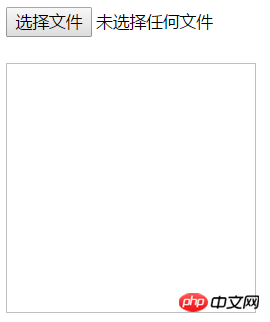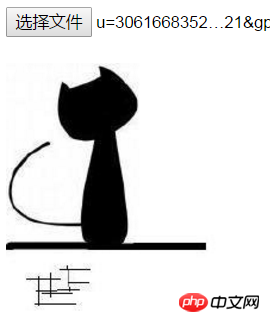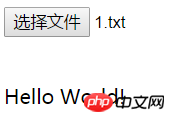
FileReader is an important part of File-API
Used to read local files
To use the file reading function
It is also necessary to instantiate the FileReader object
var fr = new FileReader();
It provides us with some interface methods and events
5 methods can be called through the instance object
4 of them A specified file reading method
Another method used to interrupt file reading
| API | Parameters | Description |
|---|---|---|
| FileReader.readAsBinaryString | File/Blob | The file is read as a binary string, each byte contains a 0 to An integer between 255 |
| FileReader.readAsText | File/Blob[,encoding] | The file is read as a text string. The default text encoding is 'UTF-8', other encodings can be specified via optional parameters |
| FileReader.readAsDataURL | File/Blob | The file is read as a Data-URI object based on Base64 encoding |
| FileReader.readAsArrayBuffer | File/Blob | The file is read as an ArrayBuffer Object |
| abort() | None | Abort file reading |
Note: Blob (Binary Large Object) is a binary object
No matter whether the file is read successfully or not
These functions will not have any return value
The read file result is stored in the result of the instantiated FileReader object
In addition to the above methods, the file reading object also contains a complete set of event models
for capturing various states during file reading
html is as follows
Simply create a file to read Get the button input
and an img tag used to display the read image
<input type="file" id="choose"><br><br><img src="" id="image" width='200px' height='200px'>

var choose = document.getElementById('choose');var img = document.getElementById('image');
choose.onchange = function(){
showImg(this, img);
}function showImg(chooseDom, imgDom){
var file = chooseDom.files[0]; //获取FileList对象的第一个元素——一个File对象
var fr = new FileReader(); //实例化FileReader对象
fr.onload = function(e){
imgDom.src = e.target.result; //e.target引用fr
}
fr.readAsDataURL(file); //读取为DataURL}After getting the node
Bind the change event to the input tagIn this way, every time a file is selected, the showImg function will be called to read it
 Verify that the read content can be checked file.type
Verify that the read content can be checked file.type
if(!/image\/\w+/.test(file.type)){
//...
return false;
}<input type="file" id="choose"><br><br><p id="demo"></p>
var choose = document.getElementById('choose');
var demo = document.getElementById('demo');
choose.onchange = function(){
showText(this, demo);
}function showText(chooseDom, textDom){
var file = chooseDom.files[0]; var fr = new FileReader();
fr.onload = function(e){
textDom.innerHTML = e.target.result;
}
fr.readAsText(file);
} File reading module
File reading module
//events事件回调对象包含
success,load,progressvar FileLoader = function (file, events) {
this.reader = new FileReader();
this.file = file;
this.loaded = 0;
this.total = file.size;
this.step = 1024 * 1024;//每次读取1M
this.events = events || {};
this.bindEvent();
this.readBlob(0);//读取第一块}
FileLoader.prototype = {
bindEvent: function (events) {
var _this = this,
reader = this.reader;
reader.onload = function (e) {
_this.onLoad();
};
reader.onprogress = function (e) {
_this.onProgress(e.loaded);
}; // start、abort、error回调暂无
},
onProgress: function (loaded) {
var percent,
handler = this.events.progress;
this.loaded += loaded;
percent = (this.loaded / this.total) * 100;
handler && handler(percent);
}, // 读取结束(每一次执行read结后调用)
onLoad: function () {
var handler = this.events.load;
// 在此发送读取的数据
handler && handler(this.reader.result);
// 如果未读取完毕继续读取
if (this.loaded < this.total) {
this.readBlob(this.loaded);
} else {
// 读取完毕
this.loaded = this.total;
// 如果有success回调则执行
this.events.success && this.events.success();
}
}, // 读取文件内容
readBlob: function (start) {
var blob,
file = this.file;
// 若支持slice方法,则分步读取,不支持就一次性读取
if (file.slice) {
blob = file.slice(start, start + this.step + 1);
} else {
blob = file;
} this.reader.readAsText(blob);
},
// 中止读取
abort: function () {
var reader = this.reader;
if(reader) {
reader.abort();
}
}
}The above is the detailed content of Specifically analyze the encapsulation of HTML5 file reading FileReader and file reading module. For more information, please follow other related articles on the PHP Chinese website!
 What are the production methods of html5 animation production?
What are the production methods of html5 animation production?
 The difference between HTML and HTML5
The difference between HTML and HTML5
 What format is doc?
What format is doc?
 Five major components of a von Neumann computer
Five major components of a von Neumann computer
 linear-gradient usage
linear-gradient usage
 The role of padding attribute in css
The role of padding attribute in css
 Solution to missing xlive.dll
Solution to missing xlive.dll
 What are the classifications of linux systems?
What are the classifications of linux systems?
 Notepad is the best
Notepad is the best




